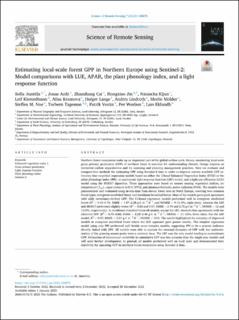Estimating local-scale forest GPP in Northern Europe using Sentinel-2: Model comparisons with LUE, APAR, the plant phenology index, and a light response function
| dc.contributor.author | Junttila, Sofia | |
| dc.contributor.author | Ardö, Jonas | |
| dc.contributor.author | Cai, Zhanzhang | |
| dc.contributor.author | Jin, Hongxiao | |
| dc.contributor.author | Kljun, Natascha | |
| dc.contributor.author | Klemedtsson, Leif | |
| dc.contributor.author | Krasnova, Alisa | |
| dc.contributor.author | Lange, Holger | |
| dc.contributor.author | Lindroth, Anders | |
| dc.contributor.author | Mölder, Meelis | |
| dc.contributor.author | Noe, Steffen M. | |
| dc.contributor.author | Tagesson, Torbern | |
| dc.contributor.author | Vestin, Patrik | |
| dc.contributor.author | Weslien, Per | |
| dc.contributor.author | Eklundh, Lars | |
| dc.date.accessioned | 2023-09-27T11:32:18Z | |
| dc.date.available | 2023-09-27T11:32:18Z | |
| dc.date.created | 2023-01-02T15:04:09Z | |
| dc.date.issued | 2023-01-03 | |
| dc.identifier.citation | Science of Remote Sensing. 2023, 7 1-14. | en_US |
| dc.identifier.issn | 2666-0172 | |
| dc.identifier.uri | https://hdl.handle.net/11250/3092377 | |
| dc.description.abstract | Northern forest ecosystems make up an important part of the global carbon cycle. Hence, monitoring local-scale gross primary production (GPP) of Northern forest is essential for understanding climatic change impacts on terrestrial carbon sequestration and for assessing and planning management practices. Here we evaluate and compare four methods for estimating GPP using Sentinel-2 data in order to improve current available GPP estimates: four empirical regression models based on either the 2-band Enhanced Vegetation Index (EVI2) or the plant phenology index (PPI), an asymptotic light response function (LRF) model, and a light-use efficiency (LUE) model using the MOD1732 algorithm. These approaches were based on remote sensing vegetation indices, air temperature (Tair), vapor pressure deficit (VPD), and photosynthetically active radiation (PAR). The models were parametrized and evaluated using in-situ data from eleven forest sites in North Europe, covering two common forest types, evergreen needleleaf forest and deciduous broadleaf forest. Most of the models gave good agreement with eddy covariance-derived GPP. The VI-based regression models performed well in evergreen needleleaf forest (R2 = 0.69–0.78, RMSE = 1.97–2.28 g C m−2 d−1, and NRMSE =9-11.0%, eight sites), whereas the LRF and MOD17 performed slightly worse (R2 = 0.65 and 0.57, RMSE = 2.49 and 2.72 g C m−2 d−1, NRMSE = 12 and 13.0%, respectively). In deciduous broadleaf forest all models, except the LRF, showed close agreements with the observed GPP (R2 = 0.75–0.80, RMSE = 2.23–2.46 g C m−2 d−1, NRMSE = 11–12%, three sites). For the LRF model, R2 = 0.57, RMSE = 3.21 g C m−2 d−1, NRMSE = 16%. The results highlighted the necessity of improved models in evergreen needleleaf forest where the LUE approach gave poorer results., The simplest regression model using only PPI performed well beside more complex models, suggesting PPI to be a process indicator directly linked with GPP. All models were able to capture the seasonal dynamics of GPP well, but underestimation of the growing season peaks were a common issue. The LRF was the only model tending to overestimate GPP. Estimation of interannual variability in cumulative GPP was less accurate than the single-year models and will need further development. In general, all models performed well on local scale and demonstrated their feasibility for upscaling GPP in northern forest ecosystems using Sentinel-2 data. | en_US |
| dc.description.abstract | Estimating local-scale forest GPP in Northern Europe using Sentinel-2: Model comparisons with LUE, APAR, the plant phenology index, and a light response function | en_US |
| dc.language.iso | eng | en_US |
| dc.publisher | Elsevier B.V. | en_US |
| dc.rights | Navngivelse 4.0 Internasjonal | * |
| dc.rights.uri | http://creativecommons.org/licenses/by/4.0/deed.no | * |
| dc.subject | Vertikal karbonfluks | en_US |
| dc.subject | Vertical carbon flux | en_US |
| dc.subject | Fjernmåling | en_US |
| dc.subject | Remote sensing | en_US |
| dc.subject | Primærproduksjon | en_US |
| dc.subject | Primærproduksjon | en_US |
| dc.title | Estimating local-scale forest GPP in Northern Europe using Sentinel-2: Model comparisons with LUE, APAR, the plant phenology index, and a light response function | en_US |
| dc.type | Peer reviewed | en_US |
| dc.type | Journal article | en_US |
| dc.description.version | publishedVersion | en_US |
| dc.rights.holder | © 2023 The Authors | en_US |
| dc.source.pagenumber | 1-14 | en_US |
| dc.source.volume | 7 | en_US |
| dc.source.journal | Science of Remote Sensing | en_US |
| dc.identifier.doi | 10.1016/j.srs.2022.100075 | |
| dc.identifier.cristin | 2098992 | |
| dc.relation.project | Norges forskningsråd: 245927 | en_US |
| dc.source.articlenumber | 100075 | en_US |
| cristin.ispublished | true | |
| cristin.fulltext | original | |
| cristin.qualitycode | 1 |
Tilhørende fil(er)
Denne innførselen finnes i følgende samling(er)
-
Divisjon for miljø og naturressurser [756]
Publikasjoner knyttet til ansatte ved Divisjon for miljø og naturressurser -
Publikasjoner fra CRIStin - NIBIO [4575]
-
Vitenskapelige artikler [1416]

